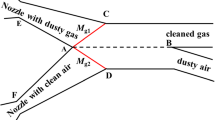Abstract
In this paper, the spatially evolving of the higher Reynolds numbers gas-solid mixing layer under compressible conditions was investigated by a new direct numerical simulation technology. A high-resolution solver was performed for the gas-phase flow-field, particles with different Stokes numbers were traced by the Lagrangian approach based on one-way coupling. The processes of the vortex rolling up and pairing in the two-dimensional mixing layer were captured precisely. The large-scale structures developed from the initial inflow are characterized by the counter-rotating vortices. The mean velocity and the fluctuation intensities profiles agree well with the experimental data. Particles with smaller Stokes numbers accumulate at the vortex centers due to the smaller aerodynamic response time; particles with moderate Stokes numbers tend to orbit around individual streamwise vortices and in the periphery of paring vortices; particles with larger Stokes numbers disperse less evenly, showing a concentration distribution in the flow field.
Similar content being viewed by others
References
Jun, Xia, Guilin, Hu, Jianren, Fan, et al. Direct Numerical Simulation of the Gas-solid Two-phase Turbulent Jets. Progress in Natural Science, 2003, 14(3): 247–256
Longmire, E K, Eaton, J K. Structure of Particle-laden Round Jet. J. Fluid Mech., 1992, 236: 217–257
Eaton, J K, Fessler, J R. Preferential Concentration of Particles by Turbulence. Int. J. Multiphase Flow, 1994, 20: 169–209
Squires, K D, Eaton, J K. Particle Response and Turbulence Modulation in Isotropic Turbulence. Physics Fluids A, 1990, 2: 1191–1203
Elghobashi, S, Truesdell, G C. On the Two-way Interaction between Homogeneous Turbulence and Dispersed Solid Particles. 1: Turbulence Modification. Phys. Fluids A, 1993, 5(7): 1790–1801
Boivin, M, Simonin, O, Squires, K D. Direct Numerical Simulation of Turbulences Modulation by Particles in Isotropic Turbulence. J. Fluid Mech., 1998, Vol.375: 235–263
Thompson, K W. Time Dependent Boundary Conditions for Hyperbolic Systems. J. Comput. Phys., 1987, 68: 1–24
Hu, F Q. On Absorbing Boundary Conditions for Linearized Euler Equations by a Perfectly Matched Layer. J. Comput. Phys., 1996, 129: 201–219
Hu, F Q. A Stable, Perfectly Matched Layer for Linearized Euler Equations in Unsplit Physical Variables. J. Comput. Phys., 2001, 173: 455–480
Poinsot, T J, Lele, S K. Boundary Conditions for Direct Simulations of Compressible Viscous Flows. J. Comput. Phys., 1992, 101: 104–129
Rudy, D H, Strikwerda, J C. A Nonreflecting Outflow Boundary Condition for Subsonic Navier-Stokes Calculations. J. Comput. Phys., 1980, 36: 55–70
Lele, S K. Compact Finite Difference Schemes with Spectral-like Resolution. J. Comput. Phys., 1992, 103: 16–42
Carpenter, M H, Gottlieb, D, Abarbanel, S. The stability of Numerical Boundary Treatments for Compact High-order Finite-difference Schemes. J. Comput. Phys, 1993, 108: 272–295
Spencer, B W, Jones, B G. Statistical investigation of Pressure and Velocity Fields in the Turbulent Two-stream Mixing Layer. AIAA Paper, 1971, 71–613
Bell, J H, Mehta, R D. Development of a Two-stream Mixing Layer from Tripped and Untripped Boundary Layers. AIAA J, 1990, 28(12): 2034–2042.
Author information
Authors and Affiliations
Rights and permissions
About this article
Cite this article
Li, W., Hu, G., Zhou, Z. et al. Direct numerical simulation of gas-solid two-phase mixing layer. J. of Therm. Sci. 14, 41–47 (2005). https://doi.org/10.1007/s11630-005-0038-7
Received:
Issue Date:
DOI: https://doi.org/10.1007/s11630-005-0038-7




